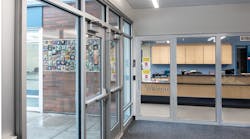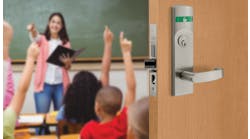A key purpose for doors and windows is to let things in — people and materials through the doors, and daylight and views of the surrounding area through the windows. But properly functioning doors and windows also have to be designed and built with security features that keep things out — unwanted intruders or objects.
Secure doors and windows are especially important for school facilities, which historically have been targets of vandalism and break-ins, and in recent years have been the scenes of deadly violence.
For some facilities, that means durable doors made of steel or solid-core wood, and windows reinforced with shatter-resistant film or covered with protective screens. Other schools may install alarms or access-control systems to enhance security at entrances. Keeping doors and windows secure also means that workers have to be vigilant about maintenance and repairs so that doors and windows can't be forced open.
Fewer and stronger
Schools being designed today typically will have fewer doors — the fewer opportunities for intruders to enter a building, the safer the students and staff are inside. At existing schools with many doors leading to the outside, doors can be retrofitted to remove exterior handles.
“You have to check the closer mechanisms and latches regularly to make sure they are working right,” says Ken Baran, facilities manager for the Howard-Suamico school district in Green Bay, Wis. “We've had instances where our staff didn't check the door, and someone was able to get into the buildings.”
Baran says after removing exterior handles from doors, his workers have installed a metal plate over the outside of the door so that potential intruders can't get any leverage to force a door open.
In most cases, even when doors away from the main school entrance have been altered to prevent unauthorized entry, the doors still can be used to exit a facility, so schools may want to use alarms or other monitoring devices to alert administrators when a door has been left open.
“The School Design Primer,” put together for the National Clearinghouse for Educational Facilities by Little & Associates, an architecture firm in North Carolina, offers several suggestions for enhancing security features in school doors and windows.
For doors:
-
Use as few doors as possible.
-
Equip key-controlled doors with contacts for alarm purposes.
-
Use doors constructed of steel, aluminum alloy or solid-core hardwood.
-
Construct frames of pry-proof metal.
-
Secure high-risk areas, such as computer labs and offices, with heavy-duty metal or solid-core hardwood doors.
-
Consider installing exterior hardware only on main doors.
-
Make sure door locks cannot be reached by breaking glass. No breakable glass should be within 40 inches of a panic bar.
For windows:
-
Use regular glass for windows in inaccessible areas and safety glass for areas that are more exposed to students.
-
Monitor the condition of windows to guard against damaged or worn window hardware that can allow easy access.
-
Make sure that first-floor windows are secured properly.
-
Consider using window guards or protective screens in areas that need additional security.
-
Avoid windows at the end of hallways because they are especially susceptible to damage by items thrown or kicked down the hall.
Protecting property
Because of a greater focus on energy efficiency and green design, school facility planners are paying more attention to how well windows conserve energy. But they also must make sure that the windows in a school do not provide an easy way for intruders to get in the building or for vandals to damage the facility.
In the Howard-Suamico district, most windows cannot be opened, and those that are operable aren't able to let much in.
“The openings are so small — they're just 9 by 9 (inches) — that they don't pose a risk,” says Baran. “They are just for ventilation.”
In “The Appropriate and Effective Use of Security Technologies,” the National Institute of Justice agrees that smaller windows are preferable. “Use narrow glazing and glass block in classrooms,” the report recommends.
The degree of security needed depends to some extent on the school surroundings. Many schools, especially in urban or high-crime areas, frequently have experienced violence or break-ins. Many of those campuses have installed window guards or protective screens to deter vandals who on a whim toss a rock at a school window and foil trespassers trying to maneuver their way into the buildings or modular classrooms on campus.
In many smaller communities, where vandalism or break-ins are not as great a concern, schools do not experience as much damage to their doors or windows, and administrators can focus more on maintaining and repairing doors and windows.
“Fortunately, we don't have to deal with much of a security problem,” says Chris Gardner, facilities director of the Blackfoot, Idaho, school district. “We have a high school that was built in 1961, and we've had to change the locks maybe once over the years.”
Kennedy, staff writer, can be reached at [email protected].
NOTABLE
-
930
Number of incidents of property damage reported in New Jersey schools in 2002-03.
-
357
Number of incidents of theft reported in New Jersey schools in 2002-03.
-
98
Number of incidents of burglary or trespass reported in New Jersey schools in 2002-03.
-
9
Number of incidents of arson reported in New Jersey schools in 2002-03.
-
$614,886
Total cost of vandalism reported in New Jersey schools in 2002-03.
Source: New Jersey Department of Education, “Violence, Vandalism and Substance Abuse in New Jersey Public Schools, 2002-2003.”
Easing the impact
In certain regions of the country, earthquake preparedness is a key part of a school safety program. Officials have to be concerned about not only making sure the structure can survive a quake, but also taking steps to prevent injuries from broken windows.
With the help of a federal program, the Helena, Mont., school district was able a few years ago to bolster the safety of the windows in all of its facilities by layering shatterproof security film on its windows. The material was provided through Project Impact, which was administered by the Federal Emergency Management Agency (FEMA).
“We have film applied to all our windows,” says David Powell, facilities manager for the Helena district. “It definitely makes a difference for safety. It's very durable.”
The film is intended to improve a school's ability to withstand damage in an earthquake. But it also can help with less destructive incidents.
“It's a deterrent to vandalism,” says Powell. “It will slow vandals down and prevent them from doing further damage.
The film in some cases can prevent objects such as rocks from breaking windows. Even in cases where a window does break, the film will hold the broken pieces in place and not allow shattered glass to scatter and cause injuries.
Powell says the district's own maintenance staff handled installation of the film.
“We sent our two glaziers for training,” says Powell. “They use a special tool, like a squeegee. It's basically trouble-free to install.”

